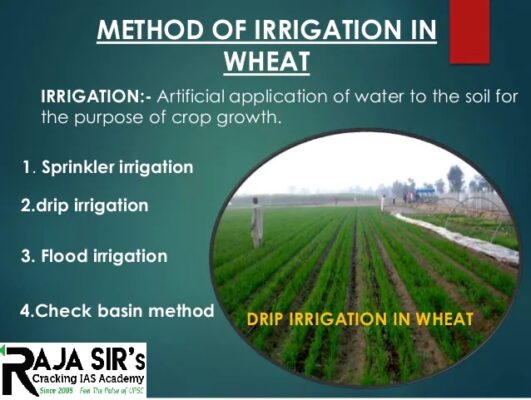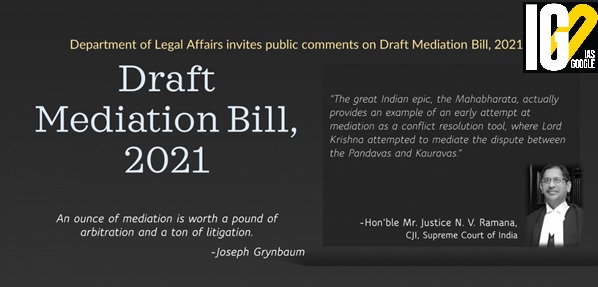- Home
- Prelims
- Mains
- Current Affairs
- Study Materials
- Test Series
 EDITORIALS & ARTICLES
EDITORIALS & ARTICLES
04th Nov 2021
IFAD: CLIMATE CHANGE ADAPTATION PROGRAM CAN ASSIST 10 MILLION PEOPLE IN ASIA AND THE PACIFIC
Recently, International Fund for Agricultural Development (IFAD) launched Building climate resilience in the Asia Pacific region report.







 Indian Renewable Energy Development Agency (IREDA) recently launched a ‘Whistle-blower Portal’, as a part of ‘Vigilance Awareness Week 2021, recently.
Indian Renewable Energy Development Agency (IREDA) recently launched a ‘Whistle-blower Portal’, as a part of ‘Vigilance Awareness Week 2021, recently.


- It will help vulnerable people in the region become resilient to climate change.

- Climate change is posing an additional threat to the Asia-Pacific region.
- The rural population dependent on rainfed agriculture has been affected.
- Climate, weather, and geophysical hazards cost the region an estimated $780 billion annually.
- The Enhanced Adaptation for Smallholder Agricultural Programme (ASAP+) will channelling an additional US$500 million in climate finance to support 10 million vulnerable people, particularly women and youth.
- There should be effective use of technology to accelerate climate risks and impacts assessments.
- Digital mapping and other technologies, along with local knowledge can be useful to identify climate-vulnerable hotspots.
- These hotspots can be provided focused support to adapt.
- Public sector initiatives should be combined with private sector players, providing inputs and machinery, advisory services, technology solutions and market access to be able to market more profitable products.
- Private players can provide the new inputs needed by small farmers when they adopt new crops and cultivation techniques.
- They should connect them with markets for new, more profitable kinds of produce.
- The project will help reduce poverty in five districts of the Haor basin of Bangladesh: Netrakona, Habiganj, Brahmanbaria, Kishorganj and Sunamganj.
- It includes poor rural people, smallholder farming households with less than 2.5 acres of land.
- Women from poor households and small traders and intermediaries in local markets.
- Aim: To improve road infrastructure, build local capacity and expand access to natural resources, technology, and markets.
- The International Fund for Agricultural Development (IFAD) is a specialized agency of the United Nations.
- It was established in December 1977.
- Headquarters: Rome, Italy
- Aim: To eradicating poverty and hunger in developing countries.
- It works in remote rural areas of the world to help countries achieve the Millennium Development Goals.
- Through low-interest loans and grants, IFAD develops and finances projects that enable rural poor people to overcome poverty.
- IFAD tackles poverty, acts an advocate for the small farmers, herders, fisherfolk, landless workers, artisans and indigenous peoples who live in rural areas.
- It works with governments, donors, non-governmental organizations, local communities, and many other partners to fight the underlying causes of rural poverty.
- IFAD support rural development programmes and projects, increase poor people's access to financial services, markets, technology, land, and other natural resources.
- The Enhanced Adaptation for Smallholder Agriculture Programme (ASAP+) is a climate financing mechanism to channeling climate finance to small scale producers.
- Help leverage existing climate finance for small-scale agricultural producers.
- Increasing the resilience of small-scale producers, transforming food systems from production to consumption.
- Reducing climate change threats to food security.
- Helping to mitigate carbon and contribute to achieving countries’ commitments, including nationally determined contributions (NDCs) and National Adaptation Plans (NAPs).

- Announced: The pledge was first announced in September by the US and EU.
- It is an agreement to reduce global methane emissions.
- Aim: To cut down methane emissions by up to 30 per cent from 2020 levels by the year 2030.
- Methane accounts for about half of the 1.0 degrees Celsius net rise in global average temperature since the pre-industrial era.
- Rapidly reducing methane emissions is complementary to action on carbon dioxide and other greenhouse gases, and is regarded as the single most effective strategy to reduce global warming.
- Methane is a greenhouse gas, which is also a component of natural gas.
- Because it is a greenhouse gas, its presence in the atmosphere increases Earth’s temperature.
- The various sources of methane including human and natural sources.
- Human sources of methane include landfills, oil and natural gas systems, agricultural activities, coal mining, wastewater treatment, and certain industrial processes.
- The oil and gas sectors are among the largest contributors to human sources of methane.
- The methane is held underground within the coal and is extracted by drilling into the coal seam and removing the groundwater.

- Reducing methane emissions can deliver a host of other energy, safety, and local air and water quality benefits.
- Methane contributes to background tropospheric ozone levels both as an ozone precursor and by contributing to global warming, which raises daytime temperatures.
- By reducing global methane emissions, one can lower tropospheric ozone formation and reduce associated mortalities, particularly in equatorial regions.
- Leachate from landfills and manure and waste from agricultural facilities can infiltrate local waters and cause disease, eutrophication, and other environmental problems.
- Producing energy from recovered methane can also help to avoid the use of higher CO2 and pollutant intensive energy resources such as wood, coal, and oil.
- It also provides local sources of alternative energy that can spur local economic development.

- Wheat is the main cereal crop in India.
- It is the second important food crop next to rice.
- Wheat producing regions in India: Uttar Pradesh, Punjab, Haryana, Madhya Pradesh, Rajasthan, Bihar and Gujarat.
- Wheat is mainly a plant of mid-latitude grasslands.
- It requires cool temperature (ideally 10° to 15°C in winter and summer temperature varying from 21°C to 26°C) with low to moderate rainfall.
- Winter and spring wheat are the two major types of the crop.
- Winter wheat is always sown in the fall;
- Spring wheat is sown in the spring but can be sown in the fall where winters are mild.

- Soils with a clay loam or loam texture, good structure and moderate water holding capacity are ideal for wheat cultivation.
- Heavy soil with good drainage is suitable for wheat cultivation under dry conditions.

- India and Italy will task the "Joint Working Group” established by the Memorandum of Understanding on Cooperation in the field of Energy, towards cooperation in areas such as:
- Smart Cities, mobility, smart-grids, electricity distribution and storage solutions.
- Gas transportation and promoting natural gas as a bridge fuel.
- Integrated waste management and green energies (green hydrogen; CNG & LNG; bio-methane; bio-refinery; etc.)
- Initiate a dialogue to support the development and deployment of green hydrogenand related technologies in India.
- To support a large size green corridor projectin India and to capitalize its target to produce and integrate 450 GW of renewable energy by 2030.
- Encourage Italian and Indian companiesto develop joint projects in natural gas sector, technological innovation for decarbonization, Smart Cities and electrification of urban public transport.
- Encourage joint investmentsin energy transition-related fields.
- Share useful informationin the field of policy and regulatory framework, to facilitate the transition in:
- Trade and Investment
- Italy is among India's top 5 trading partners in the European Union. The balance of trade has been in India’s favour since the early eighties.
- India ranks 19th as country of origin of Italian imports, accounting for 1.2%.
- Main items of Indian exports to Italy are ready-made garments, leather, iron ore, motor vehicles, textiles, chemicals, gems & Jewellery.
- Six Italian banks have representation in India.
- The Joint Economic Commission is an institutional mechanism chaired by the respective Commerce Ministers of both countries.
- There are Joint Working Groups in the following areas: Infrastructure, Tourism, Railways, Food Processing, Renewable Energy, Information Technology and Agriculture.
- Scientific Co-operation
- An Agreement on Science and Technology exists since 1978. This agreement was replaced in Nov 2003.
- The prime areas of joint research are Electronics, Biotechnology, Design Engineering Automotive Technologies, Energy, etc.
- An Executive Programme of Cooperation (EPOC) was signed for exchange of research and 10 significant joint research projects were selected from the priority areas of renewable energy, and health.
- India-Trento Programme for Advanced Research (ITPAR)was launched on 19 June 2018. recommended joint activities in the areas of
- Microsystems
- Telecommunication
- Cognitive Neurosciences
- Renewable Energy
- Quantum Physics.
- Defence:
- An MOU on Defence Cooperation was signed in November 1994.
- More than 50,000 Indian troops played a significant role in one of the bitterest advances of the allied forces for the liberation of Italy in the Second World War.
- Chief of Army Staff recently inaugurated an Indian Army memorial in the famous town of Cassino, Italy.
- The memorial has been built to pay homage to Indian soldiers who lost their lives during World War II.

- A nuclear reactor is a device used to initiate and control a fission nuclear chain reaction or nuclear fusion reactions.
- Nuclear reactors are used for electricity generation and in nuclear marine propulsion.
- Heat from nuclear fission is passed to a working fluid (water or gas), which in turn runs through steam turbines.
- The produced steam or gas drive a ship's propellers or turn electrical generators' shafts.
- Nuclear generated steam can be used for industrial process heat or for district heating.
- Some reactors are used to produce isotopes for medical and industrial use, or for production of weapons-grade plutonium.
- Uranium is the most widely used fuel by nuclear power plants for nuclear fission.
- Nuclear power plants use a certain type of uranium—U-235—as fuel because its atoms are easily split apart.
- India has been making advances in the field of thorium-based fuels and on a prototype for an atomic reactor using thorium and low-enriched uranium, a key part of India's three stage nuclear power programme done in the fusion power area through the ITER initiative.
- ITER(International Thermonuclear Experimental Reactor) is an international nuclear fusion research and engineering megaproject aimed at replicating the fusion processes of the Sun to create energy on earth.
- Members:
- The European Union, China, India, Japan, Russia, South Korea, and the United States.
- India is planning to increase the present share of nuclear energy’s contribution in electricity generation of 3 per cent to 10 per cent by 2022 and 26 per cent by 2052.
 Indian Renewable Energy Development Agency (IREDA) recently launched a ‘Whistle-blower Portal’, as a part of ‘Vigilance Awareness Week 2021, recently.
Indian Renewable Energy Development Agency (IREDA) recently launched a ‘Whistle-blower Portal’, as a part of ‘Vigilance Awareness Week 2021, recently.
- Whistle-blower portal is a part of a IREDA’s “zero tolerance” of corruption.
- Through this portal, IREDA employees can raise concerns related to fraud, corruption, abuse of power etc.

- To promote, encourage, and facilitate mediation,
- To resolve disputes, commercial and otherwise.
- To bring standalone law on Mediation on domestic and international mediation issues, as India is a signatory to the Singapore Convention on Mediation.
- To include the international practice of using the terms ‘conciliation’ and ‘mediation’ interchangeably.
- The Bill proposes pre-litigation mediation.
- It also safeguards the interest of the litigants to approach the competent adjudicatory forums/courts for urgent relief.
- Mediation Settlement Agreement could be registered with State/District/Taluk Legal Authorities within 90 days to ensure maintenance of authenticated records of the settlement so arrived.
- It provides for the establishment of the Mediation Council of India.
- It also provides for community mediation.
- The successful outcome of mediation in the form of a Mediation Settlement Agreement (MSA) has been made enforceable by law.
- The mediation process protects the confidentiality of the mediation process and provides for immunity in certain cases against its disclosure.
- ADR involves the settling of legal disputers without having recourse to the courts, to traditional adversarial litigation.
- It can take a number of forms-
- Arbitration
- Mediation
- It is a way to resolve disputes outside the judiciary courts.
- Types of Arbitration:
- Institutional Arbitration
- Ad-hoc Arbitration
- Statutory Arbitration
- Contractual Arbitration
- It is an alternative dispute resolution method in which an expert is appointed to resolve a dispute by convincing the parties to agree upon an agreement.
- It is regulated by Arbitration and Conciliation Act, 1996.
- Mediation refers to a process of settling disputes by independent and impartial third party who assists the parties to reach a common outcome.
- It is regulated by Code of Civil Procedure Act, 1908.

- HPV vaccination reduced the risk of cervical cancer by 34 % in UK women, who were aged 16-18 years when they were given the vaccine.
- The vaccine prevented around 450 cervical cancers and 17,200 cases of precancerous conditions since 2006.
- Cervical cancer occurs in the cells of the cervix, the lower part of the uterus.
- Various strains of the human papillomavirus (HPV), causes most cervical cancer.
- The virus survives for years, leading to causes of cervical cells to become cancer cells.
- Cervical Cancer begins with unusual changes in the tissue.
- Most cases are linked to infection with HPV.
- Different types of HPV can cause skin warts, genital warts, and other skin disorders.
- Bleeding between periods or after menopause.
- Pelvic pain, kidney failure, weight loss, lack of appetite and fatigue.
- HPV infection is a viral infection that commonly causes skin or mucous membrane growths (warts).
- There are more than 100 varieties of human papillomavirus (HPV).
- Some types of HPV infection cause warts, and some can cause different types of cancer.
- Types of genital HPV can cause cancer of the lower part of the uterus that connects to the (cervix). including cancers of vulva and back of the throat (oropharyngeal).
- 9-valent HPV vaccine (Gardasil 9, 9vHPV).
- Quadrivalent HPV vaccine (Gardasil, 4vHPV).
- Bivalent HPV vaccine (Cervarix, 2vHPV).
- All three vaccines protect against HPV types 16 and 18 that cause most HPV cancers.
- Globally 27 per cent of total cervical cancer cases are from India.
- About 77 percent cases are caused by HPV 16 and 18.
- In India, bivalent and quadrivalent HPV vaccines were licensed in 2008 and a non-valent vaccine was licensed in 2018.
- The Indian Academy of Pediatrics Committee on Immunization (IAPCOI) recommends HPV vaccines should be given in two-dose regimen, six months apart for girls below the age of 14 years.
- Those who are 15 and older, the vaccine is given in a three-dose regimen.









 Latest News
Latest News General Studies
General Studies